Nursing Health Assessment Report: CVD in African-American Community
VerifiedAdded on 2021/04/21
|17
|2480
|21
Report
AI Summary
This report presents a comprehensive nursing health assessment of the African-American population in the US, focusing on their vulnerability to cardiovascular disease (CVD). The assessment examines the key elements at community, group, and individual levels, including establishing assessment teams, engaging community members, defining the scope, conducting assessments, prioritizing health issues, and developing action plans. The report highlights the process for completing a comprehensive health assessment, detailing the use of the PACT model for individual assessments, encompassing physical health, substance use, psychiatric history, social development, activities of daily living, education/employment, and family relationships. Findings from secondary data analysis (literature review) and primary data (surveys) reveal that African-Americans face a significantly higher risk of CVD, linked to genetic, social, and environmental factors. The report concludes with recommendations for interventions at a large scale, emphasizing health awareness, evidence-based approaches, and the use of logic models to guide outcome-based strategies, along with the need for government support to ensure long-term impact. An appendix includes the survey questionnaire used to collect primary data.

Running head: NURSING
Nursing
Name of the Student
Name of the University
Author note
Nursing
Name of the Student
Name of the University
Author note
Paraphrase This Document
Need a fresh take? Get an instant paraphrase of this document with our AI Paraphraser
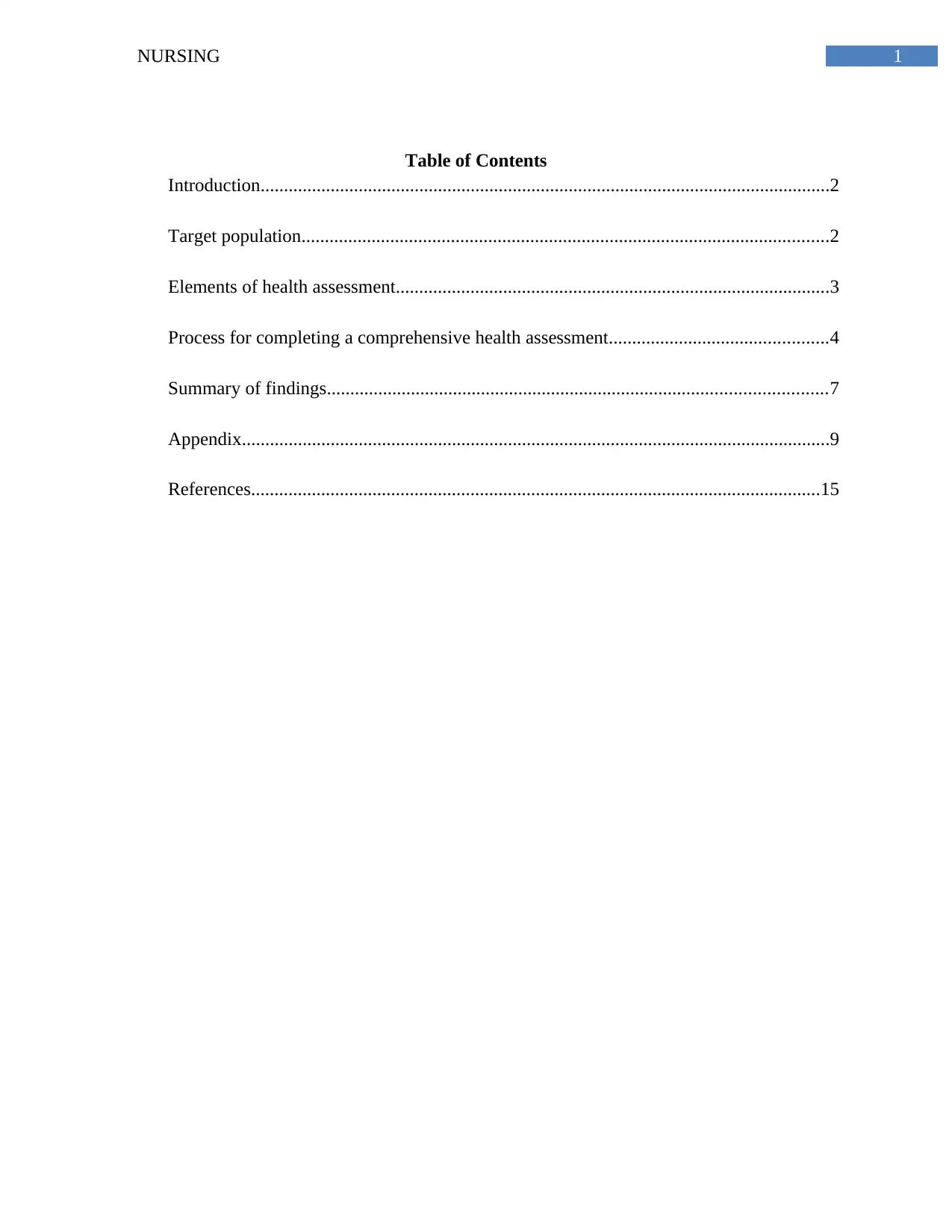
1NURSING
Table of Contents
Introduction..........................................................................................................................2
Target population.................................................................................................................2
Elements of health assessment.............................................................................................3
Process for completing a comprehensive health assessment...............................................4
Summary of findings...........................................................................................................7
Appendix..............................................................................................................................9
References..........................................................................................................................15
Table of Contents
Introduction..........................................................................................................................2
Target population.................................................................................................................2
Elements of health assessment.............................................................................................3
Process for completing a comprehensive health assessment...............................................4
Summary of findings...........................................................................................................7
Appendix..............................................................................................................................9
References..........................................................................................................................15
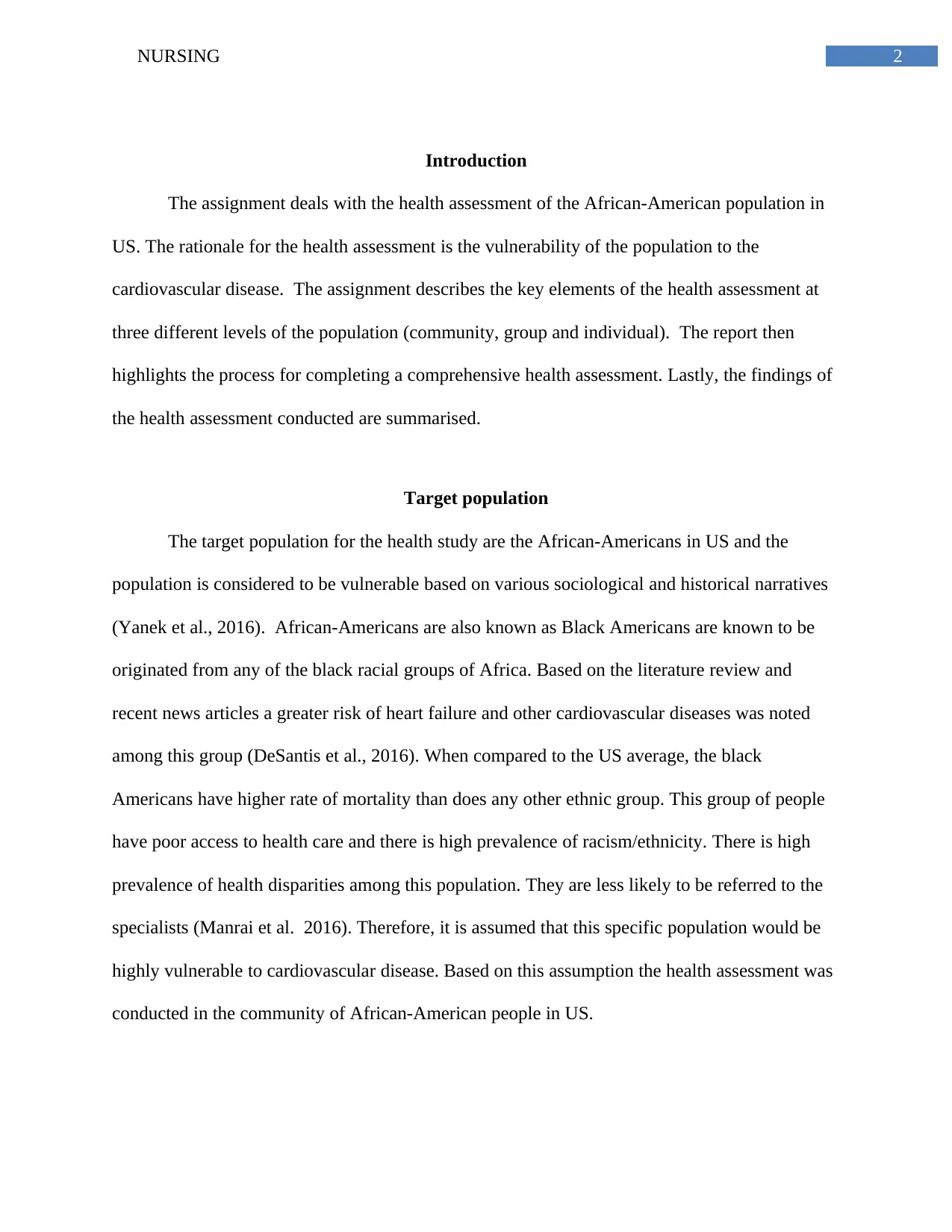
2NURSING
Introduction
The assignment deals with the health assessment of the African-American population in
US. The rationale for the health assessment is the vulnerability of the population to the
cardiovascular disease. The assignment describes the key elements of the health assessment at
three different levels of the population (community, group and individual). The report then
highlights the process for completing a comprehensive health assessment. Lastly, the findings of
the health assessment conducted are summarised.
Target population
The target population for the health study are the African-Americans in US and the
population is considered to be vulnerable based on various sociological and historical narratives
(Yanek et al., 2016). African-Americans are also known as Black Americans are known to be
originated from any of the black racial groups of Africa. Based on the literature review and
recent news articles a greater risk of heart failure and other cardiovascular diseases was noted
among this group (DeSantis et al., 2016). When compared to the US average, the black
Americans have higher rate of mortality than does any other ethnic group. This group of people
have poor access to health care and there is high prevalence of racism/ethnicity. There is high
prevalence of health disparities among this population. They are less likely to be referred to the
specialists (Manrai et al. 2016). Therefore, it is assumed that this specific population would be
highly vulnerable to cardiovascular disease. Based on this assumption the health assessment was
conducted in the community of African-American people in US.
Introduction
The assignment deals with the health assessment of the African-American population in
US. The rationale for the health assessment is the vulnerability of the population to the
cardiovascular disease. The assignment describes the key elements of the health assessment at
three different levels of the population (community, group and individual). The report then
highlights the process for completing a comprehensive health assessment. Lastly, the findings of
the health assessment conducted are summarised.
Target population
The target population for the health study are the African-Americans in US and the
population is considered to be vulnerable based on various sociological and historical narratives
(Yanek et al., 2016). African-Americans are also known as Black Americans are known to be
originated from any of the black racial groups of Africa. Based on the literature review and
recent news articles a greater risk of heart failure and other cardiovascular diseases was noted
among this group (DeSantis et al., 2016). When compared to the US average, the black
Americans have higher rate of mortality than does any other ethnic group. This group of people
have poor access to health care and there is high prevalence of racism/ethnicity. There is high
prevalence of health disparities among this population. They are less likely to be referred to the
specialists (Manrai et al. 2016). Therefore, it is assumed that this specific population would be
highly vulnerable to cardiovascular disease. Based on this assumption the health assessment was
conducted in the community of African-American people in US.
⊘ This is a preview!⊘
Do you want full access?
Subscribe today to unlock all pages.

Trusted by 1+ million students worldwide
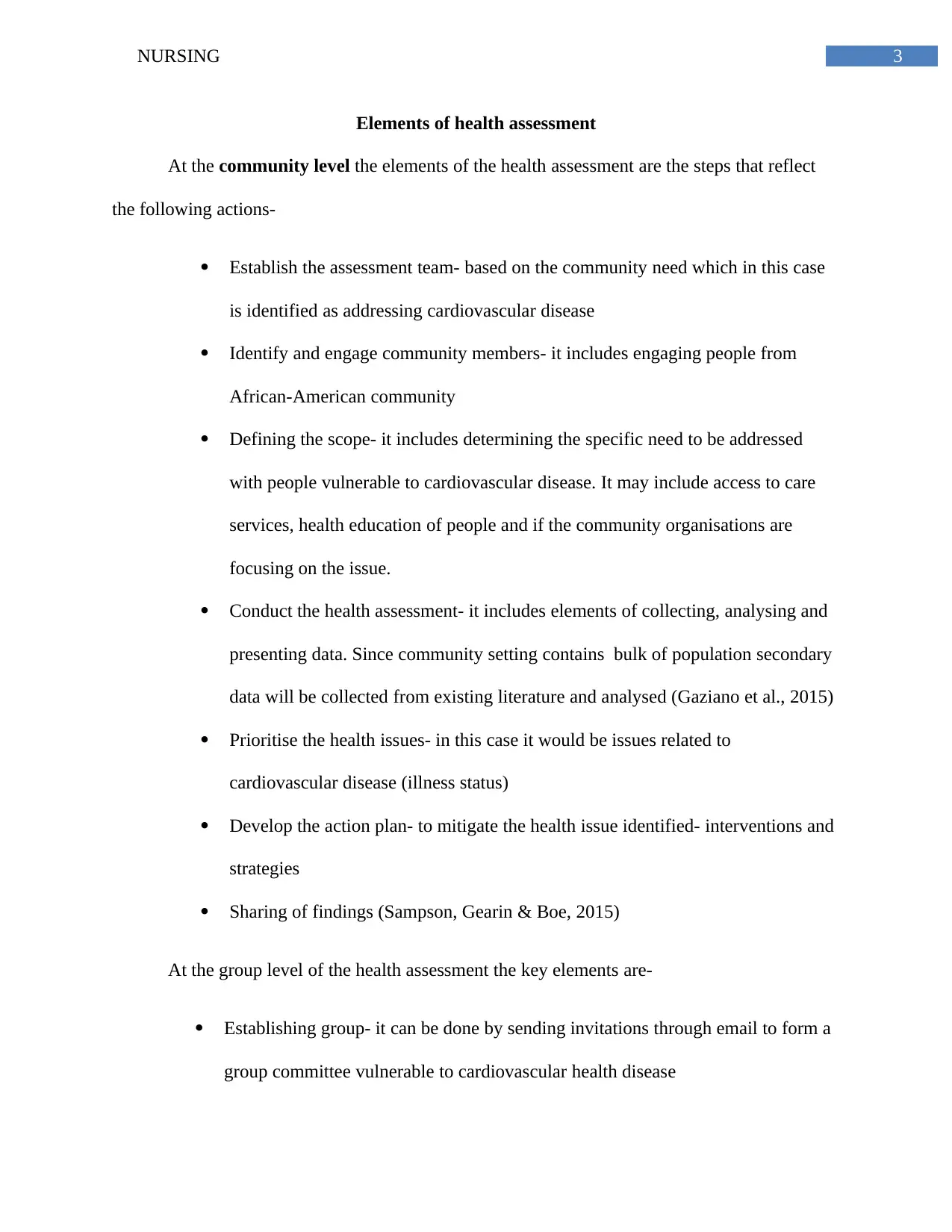
3NURSING
Elements of health assessment
At the community level the elements of the health assessment are the steps that reflect
the following actions-
Establish the assessment team- based on the community need which in this case
is identified as addressing cardiovascular disease
Identify and engage community members- it includes engaging people from
African-American community
Defining the scope- it includes determining the specific need to be addressed
with people vulnerable to cardiovascular disease. It may include access to care
services, health education of people and if the community organisations are
focusing on the issue.
Conduct the health assessment- it includes elements of collecting, analysing and
presenting data. Since community setting contains bulk of population secondary
data will be collected from existing literature and analysed (Gaziano et al., 2015)
Prioritise the health issues- in this case it would be issues related to
cardiovascular disease (illness status)
Develop the action plan- to mitigate the health issue identified- interventions and
strategies
Sharing of findings (Sampson, Gearin & Boe, 2015)
At the group level of the health assessment the key elements are-
Establishing group- it can be done by sending invitations through email to form a
group committee vulnerable to cardiovascular health disease
Elements of health assessment
At the community level the elements of the health assessment are the steps that reflect
the following actions-
Establish the assessment team- based on the community need which in this case
is identified as addressing cardiovascular disease
Identify and engage community members- it includes engaging people from
African-American community
Defining the scope- it includes determining the specific need to be addressed
with people vulnerable to cardiovascular disease. It may include access to care
services, health education of people and if the community organisations are
focusing on the issue.
Conduct the health assessment- it includes elements of collecting, analysing and
presenting data. Since community setting contains bulk of population secondary
data will be collected from existing literature and analysed (Gaziano et al., 2015)
Prioritise the health issues- in this case it would be issues related to
cardiovascular disease (illness status)
Develop the action plan- to mitigate the health issue identified- interventions and
strategies
Sharing of findings (Sampson, Gearin & Boe, 2015)
At the group level of the health assessment the key elements are-
Establishing group- it can be done by sending invitations through email to form a
group committee vulnerable to cardiovascular health disease
Paraphrase This Document
Need a fresh take? Get an instant paraphrase of this document with our AI Paraphraser
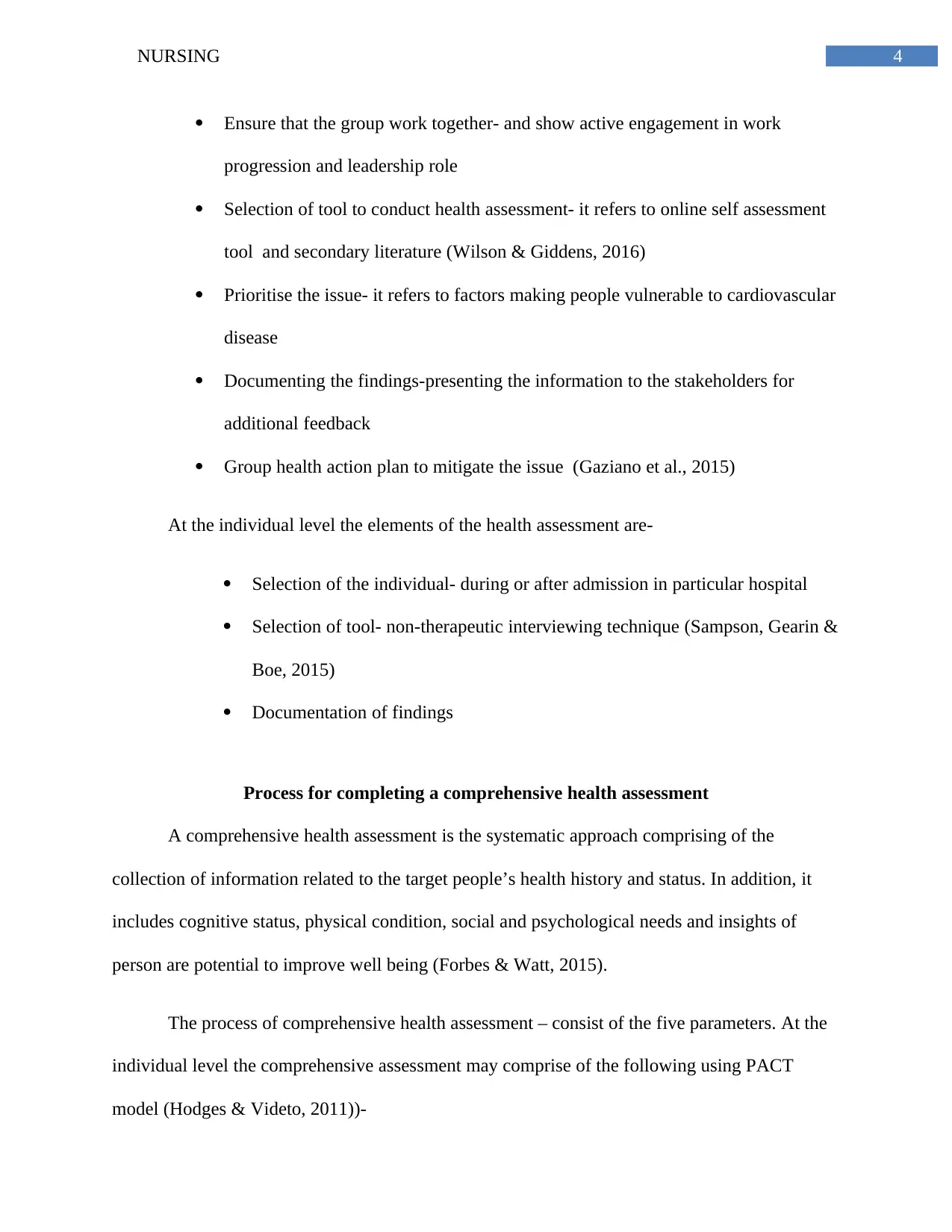
4NURSING
Ensure that the group work together- and show active engagement in work
progression and leadership role
Selection of tool to conduct health assessment- it refers to online self assessment
tool and secondary literature (Wilson & Giddens, 2016)
Prioritise the issue- it refers to factors making people vulnerable to cardiovascular
disease
Documenting the findings-presenting the information to the stakeholders for
additional feedback
Group health action plan to mitigate the issue (Gaziano et al., 2015)
At the individual level the elements of the health assessment are-
Selection of the individual- during or after admission in particular hospital
Selection of tool- non-therapeutic interviewing technique (Sampson, Gearin &
Boe, 2015)
Documentation of findings
Process for completing a comprehensive health assessment
A comprehensive health assessment is the systematic approach comprising of the
collection of information related to the target people’s health history and status. In addition, it
includes cognitive status, physical condition, social and psychological needs and insights of
person are potential to improve well being (Forbes & Watt, 2015).
The process of comprehensive health assessment – consist of the five parameters. At the
individual level the comprehensive assessment may comprise of the following using PACT
model (Hodges & Videto, 2011))-
Ensure that the group work together- and show active engagement in work
progression and leadership role
Selection of tool to conduct health assessment- it refers to online self assessment
tool and secondary literature (Wilson & Giddens, 2016)
Prioritise the issue- it refers to factors making people vulnerable to cardiovascular
disease
Documenting the findings-presenting the information to the stakeholders for
additional feedback
Group health action plan to mitigate the issue (Gaziano et al., 2015)
At the individual level the elements of the health assessment are-
Selection of the individual- during or after admission in particular hospital
Selection of tool- non-therapeutic interviewing technique (Sampson, Gearin &
Boe, 2015)
Documentation of findings
Process for completing a comprehensive health assessment
A comprehensive health assessment is the systematic approach comprising of the
collection of information related to the target people’s health history and status. In addition, it
includes cognitive status, physical condition, social and psychological needs and insights of
person are potential to improve well being (Forbes & Watt, 2015).
The process of comprehensive health assessment – consist of the five parameters. At the
individual level the comprehensive assessment may comprise of the following using PACT
model (Hodges & Videto, 2011))-
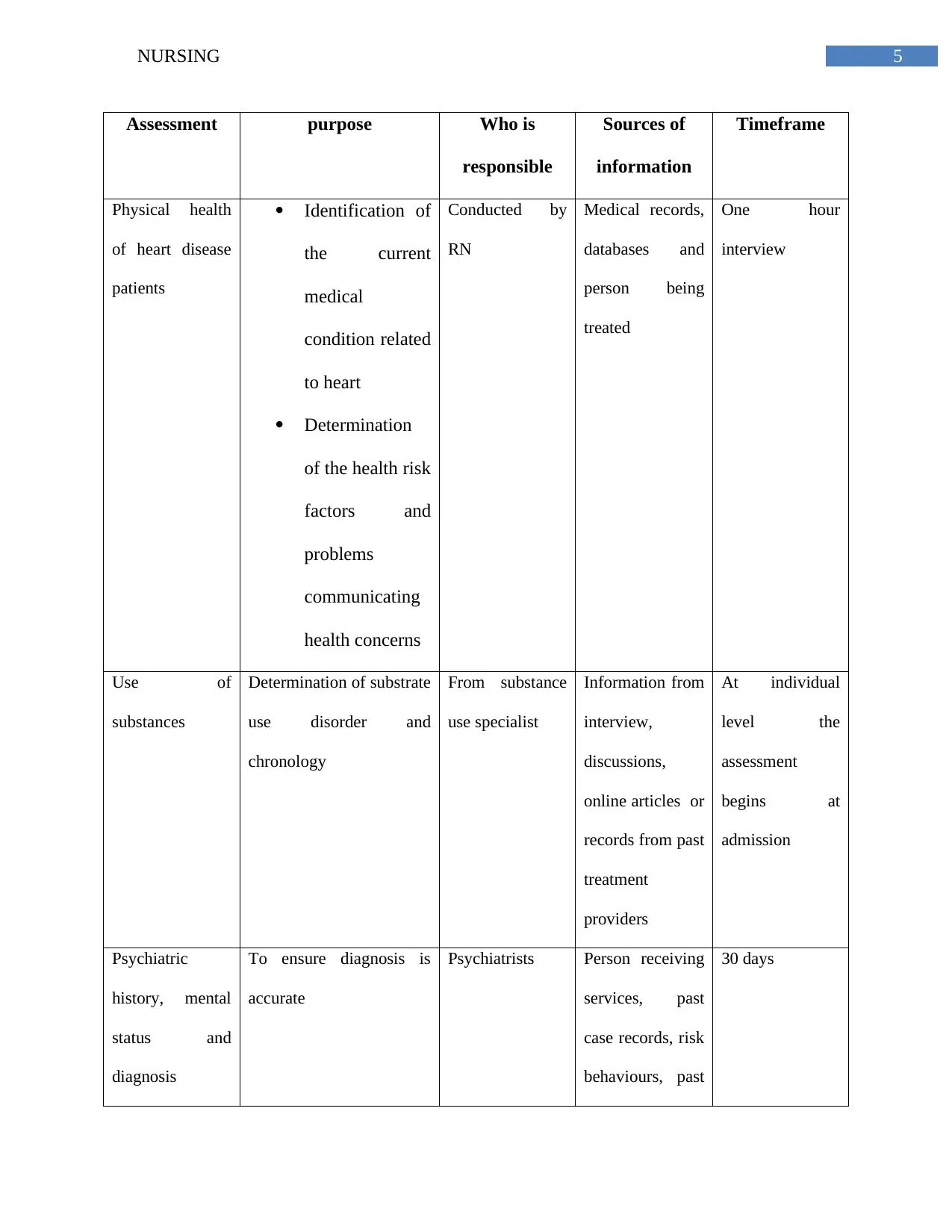
5NURSING
Assessment purpose Who is
responsible
Sources of
information
Timeframe
Physical health
of heart disease
patients
Identification of
the current
medical
condition related
to heart
Determination
of the health risk
factors and
problems
communicating
health concerns
Conducted by
RN
Medical records,
databases and
person being
treated
One hour
interview
Use of
substances
Determination of substrate
use disorder and
chronology
From substance
use specialist
Information from
interview,
discussions,
online articles or
records from past
treatment
providers
At individual
level the
assessment
begins at
admission
Psychiatric
history, mental
status and
diagnosis
To ensure diagnosis is
accurate
Psychiatrists Person receiving
services, past
case records, risk
behaviours, past
30 days
Assessment purpose Who is
responsible
Sources of
information
Timeframe
Physical health
of heart disease
patients
Identification of
the current
medical
condition related
to heart
Determination
of the health risk
factors and
problems
communicating
health concerns
Conducted by
RN
Medical records,
databases and
person being
treated
One hour
interview
Use of
substances
Determination of substrate
use disorder and
chronology
From substance
use specialist
Information from
interview,
discussions,
online articles or
records from past
treatment
providers
At individual
level the
assessment
begins at
admission
Psychiatric
history, mental
status and
diagnosis
To ensure diagnosis is
accurate
Psychiatrists Person receiving
services, past
case records, risk
behaviours, past
30 days
⊘ This is a preview!⊘
Do you want full access?
Subscribe today to unlock all pages.

Trusted by 1+ million students worldwide
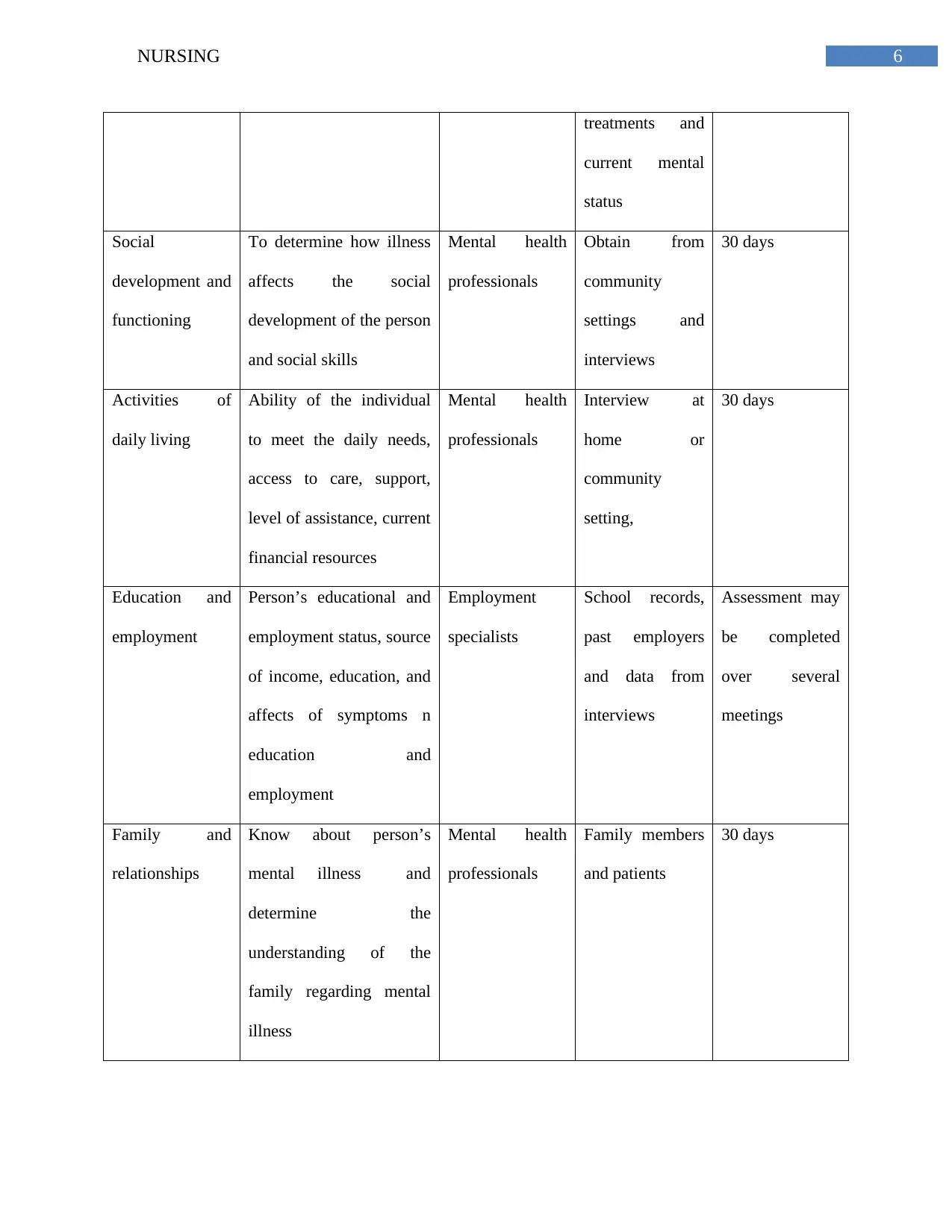
6NURSING
treatments and
current mental
status
Social
development and
functioning
To determine how illness
affects the social
development of the person
and social skills
Mental health
professionals
Obtain from
community
settings and
interviews
30 days
Activities of
daily living
Ability of the individual
to meet the daily needs,
access to care, support,
level of assistance, current
financial resources
Mental health
professionals
Interview at
home or
community
setting,
30 days
Education and
employment
Person’s educational and
employment status, source
of income, education, and
affects of symptoms n
education and
employment
Employment
specialists
School records,
past employers
and data from
interviews
Assessment may
be completed
over several
meetings
Family and
relationships
Know about person’s
mental illness and
determine the
understanding of the
family regarding mental
illness
Mental health
professionals
Family members
and patients
30 days
treatments and
current mental
status
Social
development and
functioning
To determine how illness
affects the social
development of the person
and social skills
Mental health
professionals
Obtain from
community
settings and
interviews
30 days
Activities of
daily living
Ability of the individual
to meet the daily needs,
access to care, support,
level of assistance, current
financial resources
Mental health
professionals
Interview at
home or
community
setting,
30 days
Education and
employment
Person’s educational and
employment status, source
of income, education, and
affects of symptoms n
education and
employment
Employment
specialists
School records,
past employers
and data from
interviews
Assessment may
be completed
over several
meetings
Family and
relationships
Know about person’s
mental illness and
determine the
understanding of the
family regarding mental
illness
Mental health
professionals
Family members
and patients
30 days
Paraphrase This Document
Need a fresh take? Get an instant paraphrase of this document with our AI Paraphraser
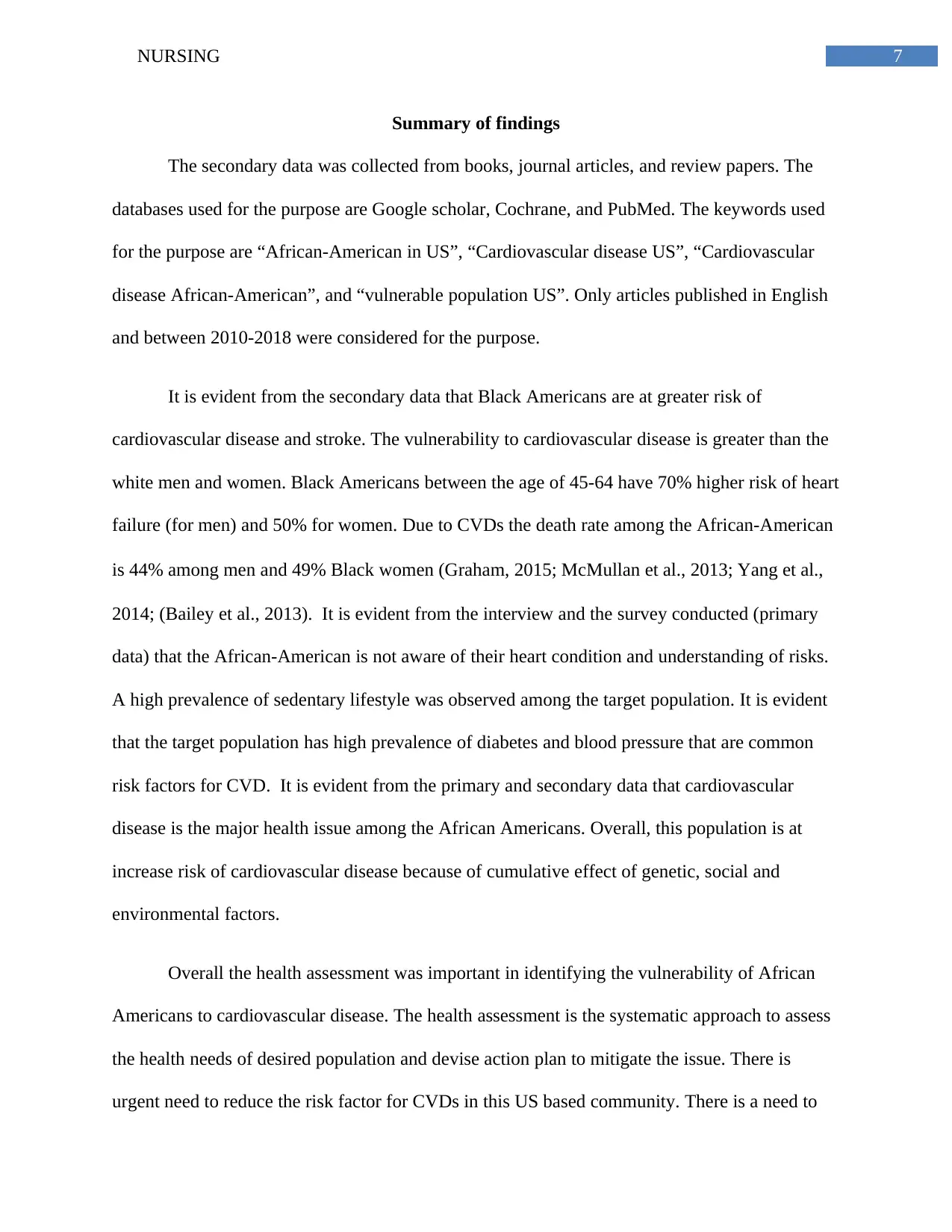
7NURSING
Summary of findings
The secondary data was collected from books, journal articles, and review papers. The
databases used for the purpose are Google scholar, Cochrane, and PubMed. The keywords used
for the purpose are “African-American in US”, “Cardiovascular disease US”, “Cardiovascular
disease African-American”, and “vulnerable population US”. Only articles published in English
and between 2010-2018 were considered for the purpose.
It is evident from the secondary data that Black Americans are at greater risk of
cardiovascular disease and stroke. The vulnerability to cardiovascular disease is greater than the
white men and women. Black Americans between the age of 45-64 have 70% higher risk of heart
failure (for men) and 50% for women. Due to CVDs the death rate among the African-American
is 44% among men and 49% Black women (Graham, 2015; McMullan et al., 2013; Yang et al.,
2014; (Bailey et al., 2013). It is evident from the interview and the survey conducted (primary
data) that the African-American is not aware of their heart condition and understanding of risks.
A high prevalence of sedentary lifestyle was observed among the target population. It is evident
that the target population has high prevalence of diabetes and blood pressure that are common
risk factors for CVD. It is evident from the primary and secondary data that cardiovascular
disease is the major health issue among the African Americans. Overall, this population is at
increase risk of cardiovascular disease because of cumulative effect of genetic, social and
environmental factors.
Overall the health assessment was important in identifying the vulnerability of African
Americans to cardiovascular disease. The health assessment is the systematic approach to assess
the health needs of desired population and devise action plan to mitigate the issue. There is
urgent need to reduce the risk factor for CVDs in this US based community. There is a need to
Summary of findings
The secondary data was collected from books, journal articles, and review papers. The
databases used for the purpose are Google scholar, Cochrane, and PubMed. The keywords used
for the purpose are “African-American in US”, “Cardiovascular disease US”, “Cardiovascular
disease African-American”, and “vulnerable population US”. Only articles published in English
and between 2010-2018 were considered for the purpose.
It is evident from the secondary data that Black Americans are at greater risk of
cardiovascular disease and stroke. The vulnerability to cardiovascular disease is greater than the
white men and women. Black Americans between the age of 45-64 have 70% higher risk of heart
failure (for men) and 50% for women. Due to CVDs the death rate among the African-American
is 44% among men and 49% Black women (Graham, 2015; McMullan et al., 2013; Yang et al.,
2014; (Bailey et al., 2013). It is evident from the interview and the survey conducted (primary
data) that the African-American is not aware of their heart condition and understanding of risks.
A high prevalence of sedentary lifestyle was observed among the target population. It is evident
that the target population has high prevalence of diabetes and blood pressure that are common
risk factors for CVD. It is evident from the primary and secondary data that cardiovascular
disease is the major health issue among the African Americans. Overall, this population is at
increase risk of cardiovascular disease because of cumulative effect of genetic, social and
environmental factors.
Overall the health assessment was important in identifying the vulnerability of African
Americans to cardiovascular disease. The health assessment is the systematic approach to assess
the health needs of desired population and devise action plan to mitigate the issue. There is
urgent need to reduce the risk factor for CVDs in this US based community. There is a need to
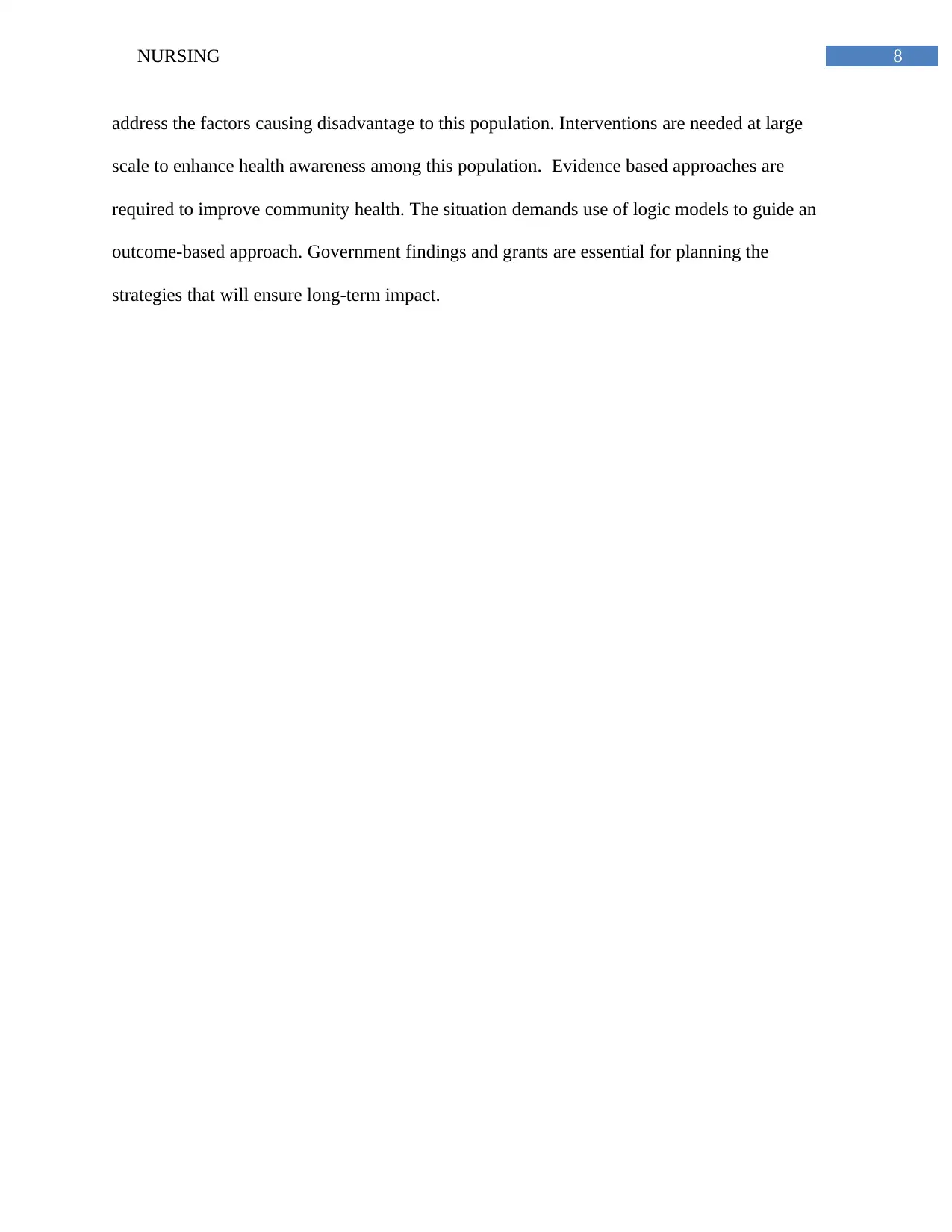
8NURSING
address the factors causing disadvantage to this population. Interventions are needed at large
scale to enhance health awareness among this population. Evidence based approaches are
required to improve community health. The situation demands use of logic models to guide an
outcome-based approach. Government findings and grants are essential for planning the
strategies that will ensure long-term impact.
address the factors causing disadvantage to this population. Interventions are needed at large
scale to enhance health awareness among this population. Evidence based approaches are
required to improve community health. The situation demands use of logic models to guide an
outcome-based approach. Government findings and grants are essential for planning the
strategies that will ensure long-term impact.
⊘ This is a preview!⊘
Do you want full access?
Subscribe today to unlock all pages.

Trusted by 1+ million students worldwide
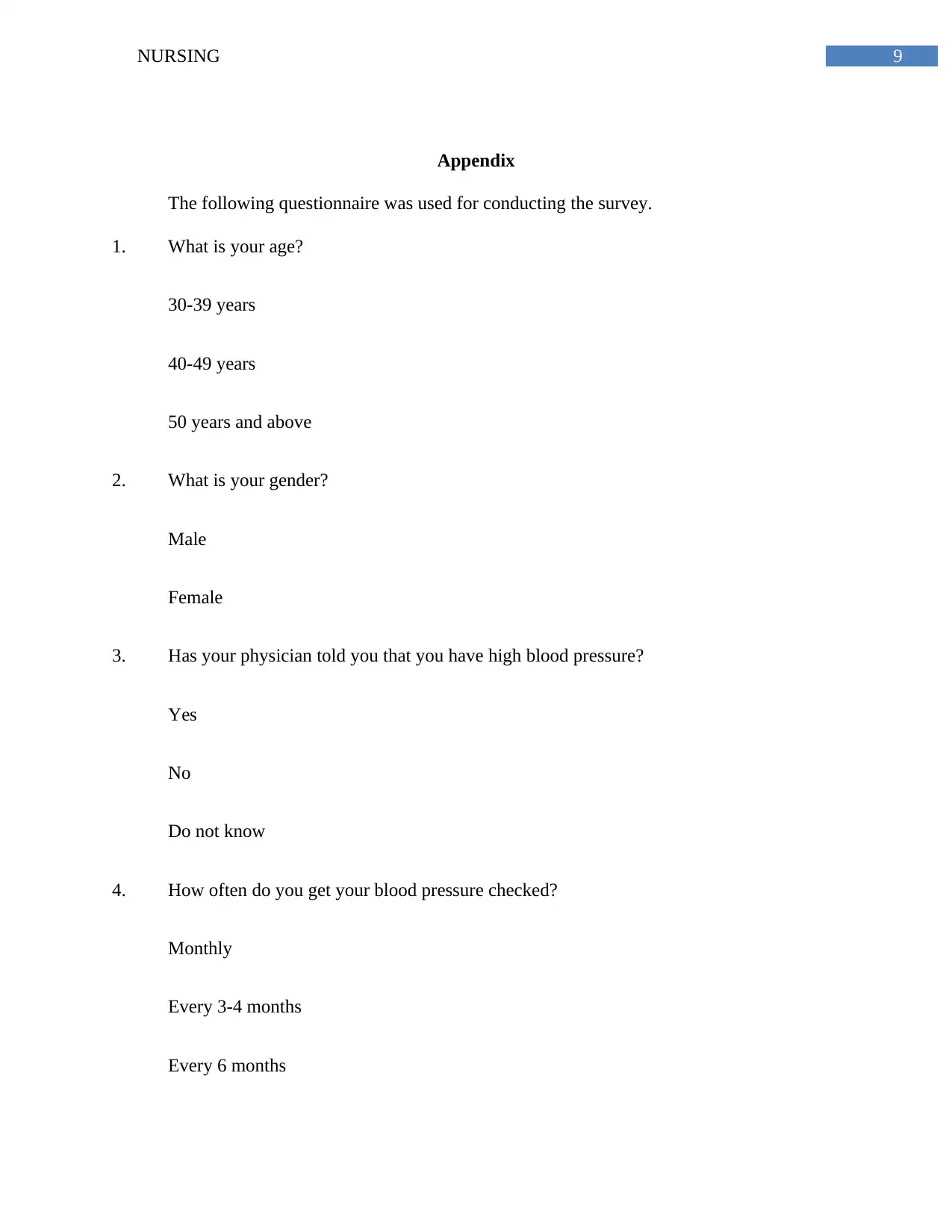
9NURSING
Appendix
The following questionnaire was used for conducting the survey.
1. What is your age?
30-39 years
40-49 years
50 years and above
2. What is your gender?
Male
Female
3. Has your physician told you that you have high blood pressure?
Yes
No
Do not know
4. How often do you get your blood pressure checked?
Monthly
Every 3-4 months
Every 6 months
Appendix
The following questionnaire was used for conducting the survey.
1. What is your age?
30-39 years
40-49 years
50 years and above
2. What is your gender?
Male
Female
3. Has your physician told you that you have high blood pressure?
Yes
No
Do not know
4. How often do you get your blood pressure checked?
Monthly
Every 3-4 months
Every 6 months
Paraphrase This Document
Need a fresh take? Get an instant paraphrase of this document with our AI Paraphraser
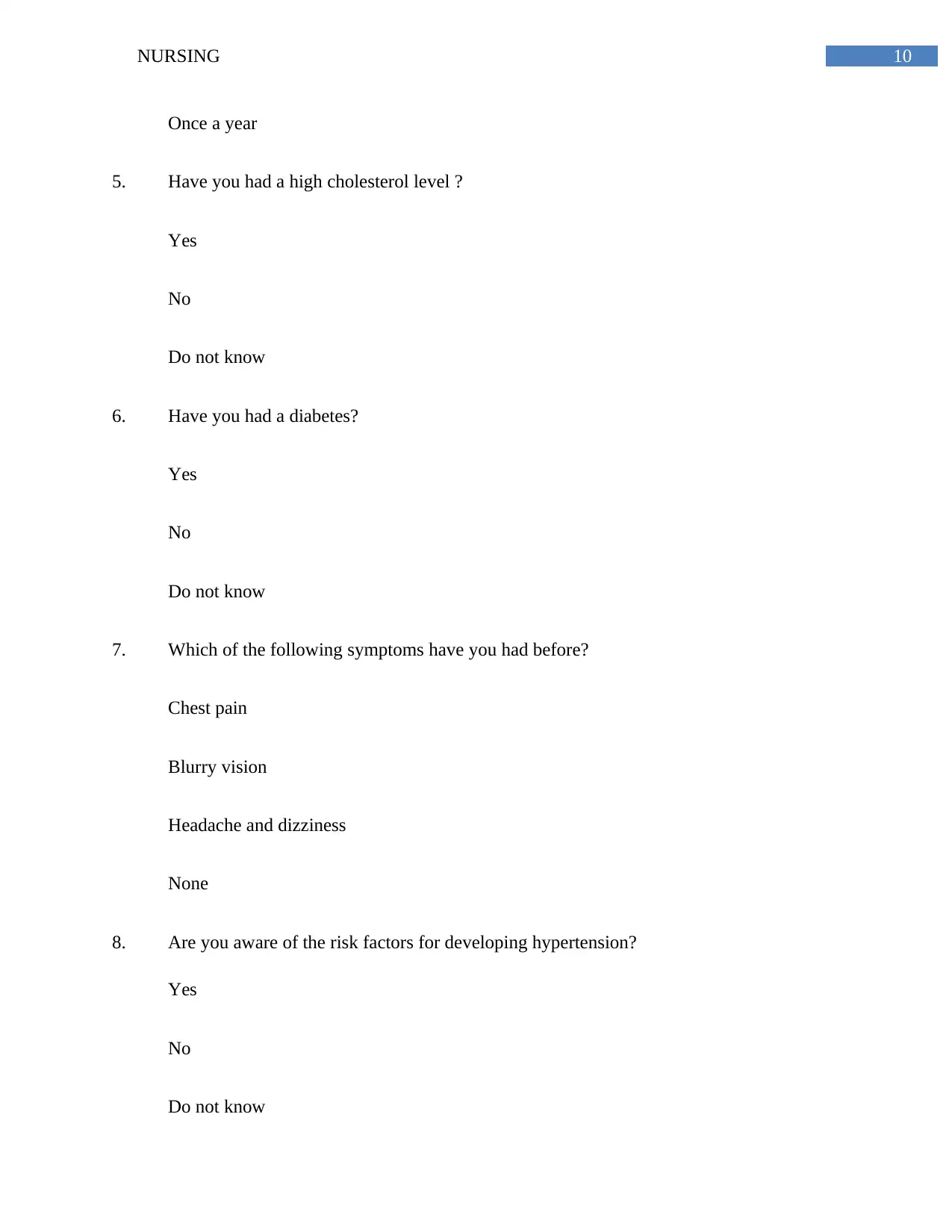
10NURSING
Once a year
5. Have you had a high cholesterol level ?
Yes
No
Do not know
6. Have you had a diabetes?
Yes
No
Do not know
7. Which of the following symptoms have you had before?
Chest pain
Blurry vision
Headache and dizziness
None
8. Are you aware of the risk factors for developing hypertension?
Yes
No
Do not know
Once a year
5. Have you had a high cholesterol level ?
Yes
No
Do not know
6. Have you had a diabetes?
Yes
No
Do not know
7. Which of the following symptoms have you had before?
Chest pain
Blurry vision
Headache and dizziness
None
8. Are you aware of the risk factors for developing hypertension?
Yes
No
Do not know
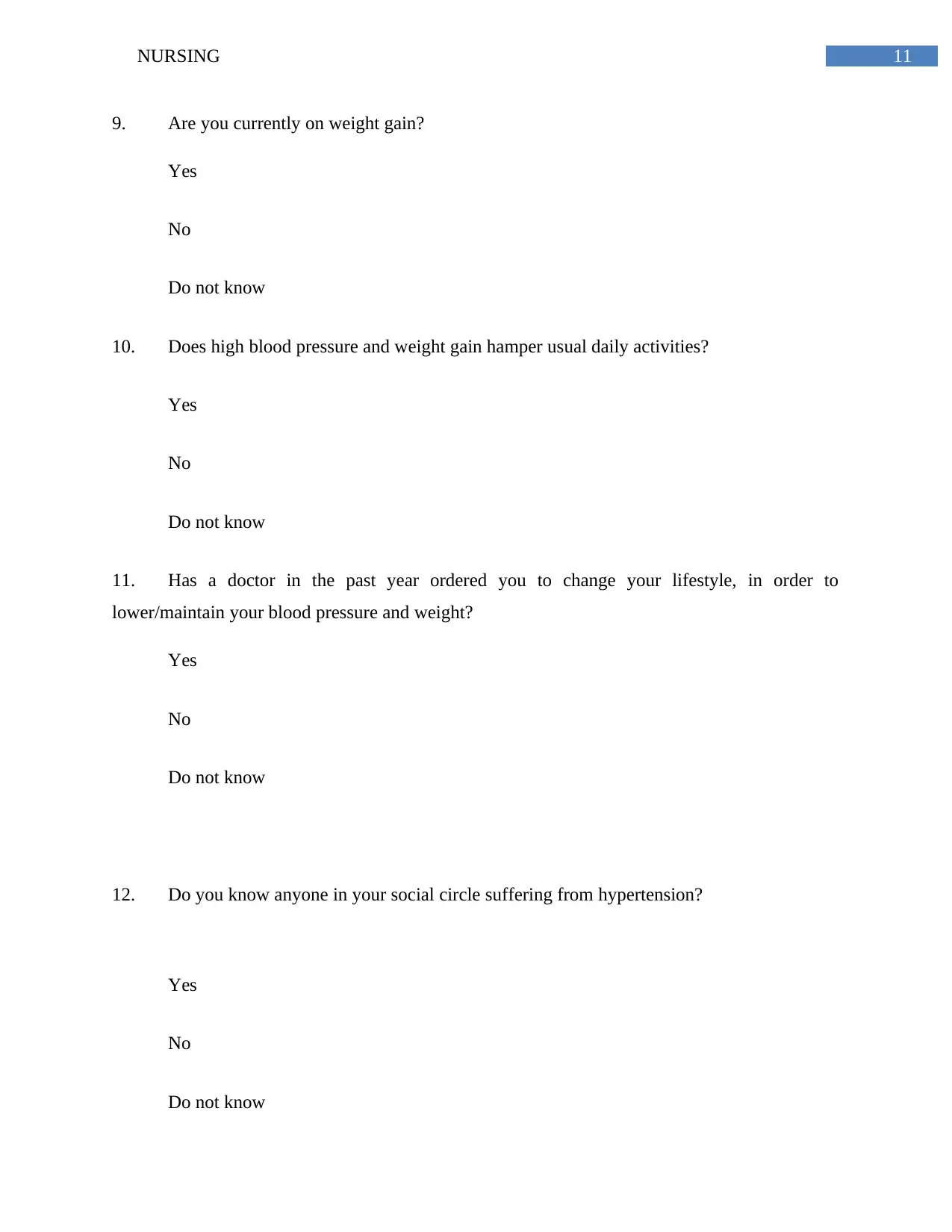
11NURSING
9. Are you currently on weight gain?
Yes
No
Do not know
10. Does high blood pressure and weight gain hamper usual daily activities?
Yes
No
Do not know
11. Has a doctor in the past year ordered you to change your lifestyle, in order to
lower/maintain your blood pressure and weight?
Yes
No
Do not know
12. Do you know anyone in your social circle suffering from hypertension?
Yes
No
Do not know
9. Are you currently on weight gain?
Yes
No
Do not know
10. Does high blood pressure and weight gain hamper usual daily activities?
Yes
No
Do not know
11. Has a doctor in the past year ordered you to change your lifestyle, in order to
lower/maintain your blood pressure and weight?
Yes
No
Do not know
12. Do you know anyone in your social circle suffering from hypertension?
Yes
No
Do not know
⊘ This is a preview!⊘
Do you want full access?
Subscribe today to unlock all pages.

Trusted by 1+ million students worldwide
1 out of 17
Related Documents
Your All-in-One AI-Powered Toolkit for Academic Success.
+13062052269
info@desklib.com
Available 24*7 on WhatsApp / Email
![[object Object]](/_next/static/media/star-bottom.7253800d.svg)
Unlock your academic potential
Copyright © 2020–2025 A2Z Services. All Rights Reserved. Developed and managed by ZUCOL.





